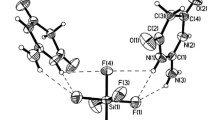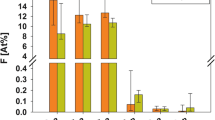Summary
Comparisons of mellitate (MA) and ethane-1-hydroxy-1, 1-diphosphonate (EHDP) have been carried out in studies of enamel etching, calcium phosphate crystal growth and animal calculus deposition. In enamel etch studies at pH 5, 6, or 7 and after treatment times of 5 or 170 min, EHDP was less damaging to enamel surfaces than MA as determined by scanning electron microscopy, grazing angle electron diffraction, and quantitative etch solution analyses. Both MA and EHDP inhibited hydroxyapatite crystal growth, although EHDP was more effective than MA. The formation of a tricalcium mellitate surface phase is suggested as the basis of the MA crystal growth effect on apatite. Both MA and EHDP also inhibited rat calculus formation, but EHDP was more effective than MA. The relation between crystal growth inhibition, surface phase solubility, and anti-calculus activity is discussed and a generalized principal for determining an effective inhibitor of calculus is suggested.
Similar content being viewed by others
References
Boskey, A.L., Posner, A.S.: Conversion of amorphous calcium phosphate to microcrystalline hydroxyapatite, A pH-dependent, solution-mediated, solid-solid conversion. J. Phys. chem.77, 2313–2317 (1973)
Briner, W.W., Francis, M.D.: In vitro and in vivo evaluation of anti-calculus agents. Calcif. Tiss. Res.11, 10–22 (1973)
Francis, M.D.: Methods of evaluating tin and fluoride salts as anti-caries agents inanimal caries experiments. J. dent. Res.44, 635–643 (1965)
Francis, M.D.: The inhibition of calcium hydroxyapatite crystal growth by polyphosphonates and polyphosphates. Calcif. Tiss. Res.3, 151–162 (1969)
Francis, M.D., Briner, W.W.: Animal calculus: methods of evaluation and of dietary production and control. J. dent. Res.48, 1185–1195 (1969)
Francis, M.D., Briner, W.W.: The effect of phosphonates on dental enamel in vitro and calculus formation in vivo. Calcif. Tiss. Res.11, 1–9 (1973)
Francis, M.D., Gray, J.A., Griebstein, W.J.: The formation and influence of surface phases on calcium phosphate solids. Adv. oral. Biol.3, 83–120 (1968)
Francis, M.D., Russell, R.G.G., Fleisch, H.: Diphosphonates inhibit formation of calcium phosphate crystals in vitro and pathological calcification in vivo. Science165, 1264–1266 (1969)
Francis, M.D., Webb, N.C.: Hydroxyapatite formation from a hydrated calcium monohydrogen phosphate precursor. Calcif. Tiss. Res.6, 335–342 (1971)
Gray, J.A., Francis, M.D.: Physical chemistry of enamel dissolution. In: Mechanisms of hard tissue destruction (Sognnaes, R.F., ed.), pp. 213–260. Washington, D.C.: AAAS 1963
Johansen, E.: A new technique for oral examination of rodents. J. dent. Res31, 361–365 (1952)
Leach, S.A.: Dental plaque inhibiting agents which prevent deposition of calcium hydroxyapatite from saliva. Patent Number DT 2411-383, submitted 10.03.73.
Lucena-Conde, F., Prat, L.: A new reagent for the colorimetric and spectrophotometric determination of phosphorus arsenic, and germanium. Anal. chim. Acta16, 473–479 (1957)
Mühlemann, H.R., Bowles, D., Schait, A., Bernimoulin, J.P.: Effect of diphosphonate on human supragingival calculus. Helv. Odont. Acta14, 31–33 (1970)
Schafer, W.G., Hine, M.K., Levy, B.M.: Textbook of oral pathology, 2nd ed., pp. 647–648. Philadelphia: W. B. Saunders 1964
Shannon, I.L., Carroll, E.C., Madsen, K.D.: Dietary influence on the formation of dental calculus in rats. J. Periodont. Res.5, 191–195 (1970)
Snedecor, G.W., Cochran, W.G.: Statistical methods, 6th ed., pp. 273–275. Ames: Iowa State College Press 1967
Sturzenberger, O.P., Swancar, J.R., Reiter, G.: Reduction of dental calculus in humans through the use of a dentifrice containing a crystal growth inhibitor.J. Periodontol.42, 416–419 (1971)
Suomi, J.D., Horowitz, H.S., Barbano, J.P., Spolsky, V.W., Heifetz, S.B.: A clinical trial of a calculus-inhibitory dentifrice. J. Periodontol.45, 139–145 (1974)
Author information
Authors and Affiliations
Rights and permissions
About this article
Cite this article
Francis, M.D., Slough, C.L., Briner, W.W. et al. An in vitro and in vivo investigation of mellitate and ethane-1-hydroxy-1, 1-diphosphonate in calcium phosphate systems. Calc. Tis Res. 23, 53–60 (1977). https://doi.org/10.1007/BF02012766
Received:
Accepted:
Issue Date:
DOI: https://doi.org/10.1007/BF02012766




